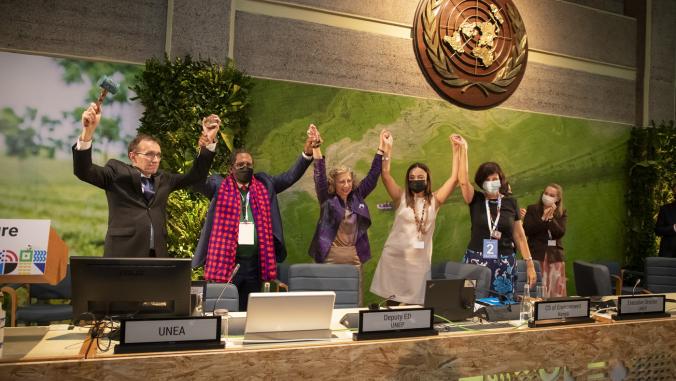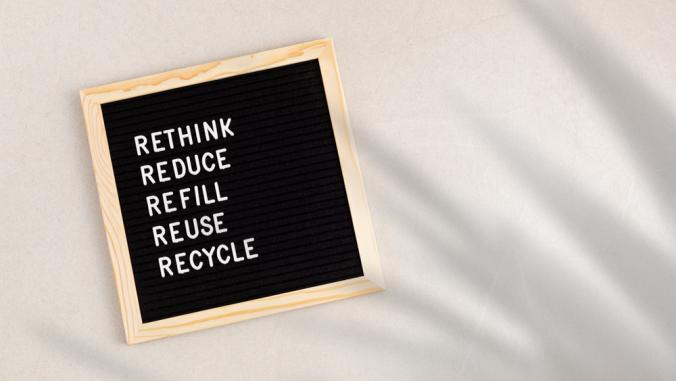Catching up with circular design pioneer Bill McDonough
The foundational thinker and author chats about why we need more practical examples of what's working in the world of circularity.

The "father of the circular economy" longs for more practical examples of what's working.
This article has been adapted from GreenBiz's Circular Weekly newsletter. Subscribe here.
Every emerging industry needs pioneers and champions. In recent months, I’ve been conducting a series of interviews with circular economy leaders who are driving the transition from linear to circular.
In the still relatively small community of circular economy practitioners, everyone knows Bill McDonough. His work has played a pivotal role in the development and popularization of what we now call circularity. Most recently, McDonough was named by Fortune Magazine as one of the World’s 50 Greatest Leaders just prior to joining us onstage in June at Circularity 19 for a conversation about integrating circularity into a company’s genes and jeans with C&A and Fashion for Good, the Amsterdam-based nonprofit he helped found.
I remember reading McDonough and Michael Braungart’s 2002 book "Cradle to Cradle: Remaking the Way We Make Things" in my high school environmental science class, discussing the promising vision of an industrial model in which "waste equals food" and speculating about what it would take to get there. Many years later, I’m struck by how resonant the same challenges and solutions still are today, and still within reach. Little did I know that McDonough would become a colleague and friend, and his book’s teachings would center so directly on my work.For me, it’s all one thing: design as the first signal of human intention.
I recently caught up with McDonough. Here are excerpts from our conversation, edited for clarity and length.
Lauren Phipps: What are you excited about right now?
Bill McDonough: I’m working in about 10 sectors: cities; plastics; apparel; building design; renewable energy; in lots of different places. Watching everything we’ve been talking about with Cradle to Cradle for all these years and watching them manifest in so many ways in so many places is very exciting.
When we see large organizations adopt the protocols and take these things up, that’s exciting. When we see the work that we were doing in China 20 years ago manifesting vigorously, that’s exciting. When I get to work with the big companies on redesigning plastics and developing protocols for packaging, that’s exciting. We are working on a strategy for how to move recycling of plastics from 11 percent to 90 percent by 2050; that’s exciting. We’re working in marine planning protocols to protect reefs and seascapes. That’s exciting.
For me, it’s all one thing: design as the first signal of human intention. What’s exciting for me now is how many people recognize this and are integrating it into their work.
Phipps: What is the biggest obstacle to advancing your work, and circularity more broadly?
McDonough: Practical examples that are cost-effective and show the full potential of this kind of work. For example, when I was recently in Hong Kong and I was sitting with one of the largest apparel makers and I explained what the perfect jean looked like — the new elastanes and the organic cotton and the dye protocols, all safe and healthy down to the parts per billion. At the end, after everyone said "This is beautiful, this is perfect, but what’s the price?" and I replied, "The shirts are [$7.79] and the jeans are [$31.16]." They said, "Wow, that’s pretty great." And I added, "Retail." And they said, "Oh my god, you’ve done it." That’s what we need.
We need to have the language of commerce to connect the idea that this is highly productive work and practical. We can aim for something that is such a high quality and yet meets the value propositions that are required by the market. We need both the quality and the quantity.
What concerns me is that the economy is meant to be comprised of goods and services. In Cradle to Cradle, we propose goods as services as well — the product-as-a-service concept — which is now being seen as something exciting. You want the service of a washing machine, an engine or a light fixture, not necessarily ownership of the materials, which can be kept as an asset within the industries.I’m really interested in watching business rise to the occasion of saying that things need to be safe, and then recirculate them.
The notion of goods and services is critical because we call them goods. What if they were bads? There are certain carpets made from PVC, for example, which isn’t an ideal material at all. And yet, when we recycle it, we’re circular. But what if we’re circulating a sub-optimal thing? I’m really interested in watching business rise to the occasion of saying that things need to be safe, and then recirculate them. Just because something is recycled doesn’t make it good.
Phipps: What’s keeping you up at night?
McDonough: The opportunity is so immense and the take-up so small and slow. I keep looking at the frameworks that people can adopt, but also those acupuncture points where we can actually do the work that illustrates what we’re talking about instead of just talking or articulating theory. This has been a really important part of the framing of circular economy, and it’s time to put it into play.
What keeps me up at night is how quickly we can make the examples that can be used to illustrate the ideas and ways that people will move toward quick adoption. When I look back at when we did our first textiles this way in 1994 — so safe you could eat them, with 20 percent less cost — beautiful, beautiful products. And then with Herman Miller and Steelcase — products that are designed for disassembly and reuse of materials — these are wonderful things.
It’s only now that we are starting to see the ability to take back, use blockchain, track things. The tools are all arriving now. How do we get all these tools to coordinate around these principled behaviors and activities so we’re not just trying to figure out how to do the wrong thing faster or how to perfect things that were totally sub-optimal so that they become perfectly wrong? We’re looking for those things that can be done perfectly right.
What keeps me up at night is making sure we don’t get lost in this idea that just because we’re doing something big, it’s good. We really need to be doing things that rise to our own occasions as a creative species that are generous and graceful and safe and healthy for all generations, not just for the moment.





